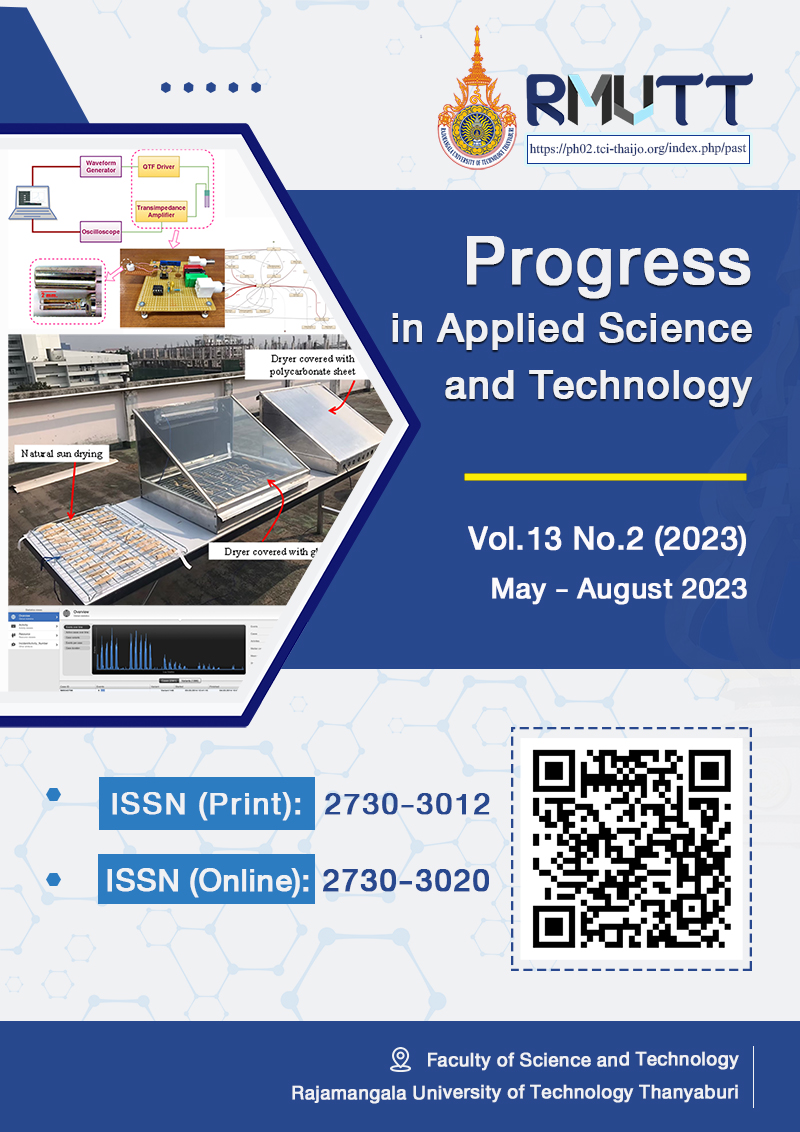Optimum Conditions and Comparison of Extraction Methods of Red Roselle Water on the Contents of Anthocyanin, Total Phenolic, Total Flavonoid, and Anti-Radical Scavenging Activity
Main Article Content
Abstract
Red roselle (Hibiscus sabdariffa L.) is an herb that is widely used. Because it has a wide variety of properties and also contains the main substance such as anthocyanin. Which is a substance that has two times higher antioxidant activity than Vitamin C and Vitamin E. This research aimed to study the optimum conditions for extracting red roselle water on the contents of anthocyanin, total phenolic, total flavonoid, and anti-radical scavenging activity. Red roselle with moisture contents of 19.92 percent was used and extracted with water in a ratio of 1:10 w/v (Red roselle from Non-Sung, Nakhon Ratchasima). It was extracted by using 4 methods, there Microwave extraction method at 100 (100 W ME) and 200 watts (200 W ME), the Boiling method (BE), the Maceration method (MA) at 25ºC and room temperature (METR) and Sonication extraction method (SE) for 7 15 30 45 60 120 180 and 240 minutes. The results showed the optimum conditions for extraction of Red roselle water on anthocyanin content were boiling extraction for 15 minutes. showed anthocyanin content cyanidin-3-glucoside and pelargonidin-3-glucoside 35.58±1.07 and 21.01±0.63 mg/L respectively. Extraction methods with the highest total phenolic content and total flavonoid content were extracted with microwave 100 watts for 30 minutes showing total phenolic content was 1,234±12.09 µg GAE/mL extract. The total flavonoid content was 141.71±1.06 µg QE/mL extract. The extraction methods with the highest anti-radical scavenging activity were sonication extraction for 7 min. The anti-radical scavenging activity was 134.02 ±1.85 µg Vit.CE/mL extract. Red roselle water extract of each condition showed a pH in the range of 2.00-2.50.
Article Details

This work is licensed under a Creative Commons Attribution-NonCommercial-NoDerivatives 4.0 International License.
References
Dey S, Roy A, Paul A, Saha N, Tarafdar A, Mazumder S. Food and medicinal properties of hibiscus (Hibiscus sabdariffa & Hibiscus rosa-sinensis). SAFER, 2023;11:2528.
Islam A, Jamini TS, Islam M, Yeasmin S. Roselle: A Functional Food with High Nutritional and Medicinal Values. Fundam Appl Agric. 2016;1:44-9.
Müller L, Bednár P, Barták P, Lemr K, Sevcík J. Estimation of partition coefficients by MEKC Part 2: Anthocyanins. J Sep Sci. 2005;28:1285-90.
Diaconeasa Z, Stirbu I, Xiao J, Leopold N, Ayvaz Z, Danciu C, Ayvaz H, Stanila A, Nistor M, Socaciu C. Anthocyanins, Vibrant Color Pigments, and Their Role in Skin Cancer Prevention. Biomedicines. 2020;8:1-50.
Mattioli R, Francioso A, Mosca L, Silva P. Anthocyanins: A Comprehensive Review of Their Chemical Properties and Health Effects on Cardiovascular and Neurodegenerative Diseases. Molecules. 2020;25:1-42.
Udchachon S, Chanthai S. Determination of Anthocyanin in Mao Juice by Spectrofluorophotometry. KKU Res J. 2015;15:39-47.
Association of Official Analysis Chemists (AOAC). Official Methods of Analysis of the Association of Official Analytical Chemists. 17th ed. Arlington: Virginia; 2000.
Lee J, Durst RW, Wrolstad RE, Collaborators. Determination of total monomeric anthocyanin pigment content of fruit juices, beverages, natural colorants, and wines- pH differential method. J. AOAC Int. 2005;88:1269-78.
Meechai I, Phupong W, Chunglok W, Meepowpan P. Antioxidant Properties and Phytochemical Contents of Garcinia schomburgkiana Pierre. J. Appl. Pharm. Sci. 2016;6:102-7.
Ployraya N, Sritharet N, Malila Y, Bunchasak C, Cawawintaweewat S. Effects of Roselle (Hibiscus sabdariffa Linn.) in Drinking Water on Production, Haematological Parameter and Blood Lipid Profile of Broilers under High Stocking Density. TSTJ. 2018;24:639-47.
Narkprasom K, Boonmee N, Kaewwongsa W, Kaewwongsa N, Tanongkankit Y. The Optimal Condition for Anthocyanin Extraction from Roselle (Hibiscus sabdariffa L.). The 3nd Conference on Research and Creative Innovations 2016. p. 380-7.
Sompongse W, Teerasilvesakul P, Seesaleekularat K. Extraction of Tamarind Seed (Tamarindus indica L.) Gum by Microwave and Its Application in Strawberry Jam. TSTJ. 2016;24:288-98.
Cavalcanti RN, Diego TS, Maria AA. Non-thermal stabilization mechanisms of anthocyanins in model and food systems-An overview. Food Res. Int. 2011;44:499-509
Singh R, Singh P, Pandey VK, Dash KK, Ashish, Mukarram SA, Harsányi E, Kovács B. Microwave-Assisted Phytochemical Extraction from Walnut Hull and Process Optimization Using Box–Behnken Design (BBD). Processes. 2023;11:1243.
Wolfe KL, Liu RH. Structure-activity relationships of flavonoids in the cellular antioxidant activity assay. J. Agric. Food Chem. 2008;56:8404-11.
Jaka HMI, Santoso H. Natural red dyes extraction on roselle petals. IOP Conf. Ser.: Mater. Sci. Eng. 2016;162:012029.






